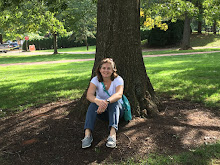It was an honor to be a part of the panel at this event at Carroll Square Gallery on January 19. I was truly impressed with the crowd that gathered on a cold Sunday of a holiday weekend to come out for fellowship and discussion of the children's art. For me, it was great to get to present beside one of my most important mentors and to realize that although my path as a professional has taken me to a different kind of work, my work with Tracy Councill was truly foundational in developing my own ideas on children's art and the power of building relationships through art.
Tracy began the discussion with a talk on three elements to keep in mind in looking at children's art: development, expressive qualities and relationship. She elaborated on development, describing how children's art provides a constantly changing and evolving visual record of how children see and represent the world. Each stage in development is unique and children are constantly growing and changing in their perceptions; their art is a wonderful record of this. She also spoke about the expressive qualities of children's art and the importance of seeing childhood emotional experience as real experiences with the same power of feeling as adult emotions. She spoke of how art can allow children to express and then see and reflect on these powerful emotions. Finally, my favorite part of her talk was on relationship and the importance of relationship in the studio and in the art making process. Children need to feel safe, respected and able to grow at their own pace in a supportive environment. This is what I remember most about my time in the studio with Tracy at Lombardi Cancer Center. Not only did the studio and art therapists provide a safe and supportive place to create art, there was something about sitting together creating that opened people up to connecting and developing relationships through shared experience. For my part of the talk, I built on Tracy's idea of relationship in describing my work at Art at the Center. We are a community based studio lab for children and families. We are process-focused and aim to provide time, space and materials for children and families to explore and create. Knowing child development and sharing Tracy's fascination with getting to watch these stages unfold is an important part of working in this way. Process art is also about letting go as a facilitator and letting the participants lead you through sharing in their process. My favorite thing that happens in the studio is when a child delights or surprises ME with a creative solution to a problem. I believe the studio offers a unique opportunity for building empathy between parents and children because of the inherent vulnerability of creativity. Many adults are still intimidated by art making and so are not too far ahead of their child in ability when they enter the studio. I love watching adults learn and explore alongside their children and hearing children share their expertise with parents on different materials and processes. It is not unusual for young artists to know more than their parents about clay and the firing process. The ateliers of Reggio-inspired schools are a source of inspiration for my own space. An atelier is place for exploring ideas, emotions and theories through the use of materials in a supportive space. The latest project for Art at the Center is to encourage the extension of the spirit of the studio into homes through my new books designed to build on shared reading time and to help families begin the process of creating together with printing and collage. It was delightful to have COLLETTE: A Collage Adventure and Oops Paint be a part of the event. Thinking about children's art in homes, the final presenter, Shazalynn Calvin-Winfrey shared thoughts on ways to catalog, preserve and display children's art in the home. I was interested to learn how much she notices that early environment influences personal taste in her interior decorating clients. She shared ideas for display that included mounting, matting and framing as well as using ledge shelves to be able to rotate a collection as more art comes home. It was wonderful to see her own images of her two children's art sprinkled throughout her home, often amid displays of pottery or painting by professional artists. She really got my attention when she said how even though her children may not notice or even think about their art at home on a regular basis, when they look back they will remember their creations as being an integral part of their daily living. We teach children what we value by how we set up our environment and take care of things. The question and answer session also included other ideas for cataloging and displaying children's creations including recording sculptures with digital photography, keeping portfolios, and inviting children to tell and record the stories of their creations.
A rich question and answer period and discussion followed the presentations and it was great to be among a group of people so dedicated to children's art and creativity. Hemphill Fine Arts did a lovely job displaying the art and Shira Kraft was a wonderful resource hosting the event. Thanks who all who came out to join us!
